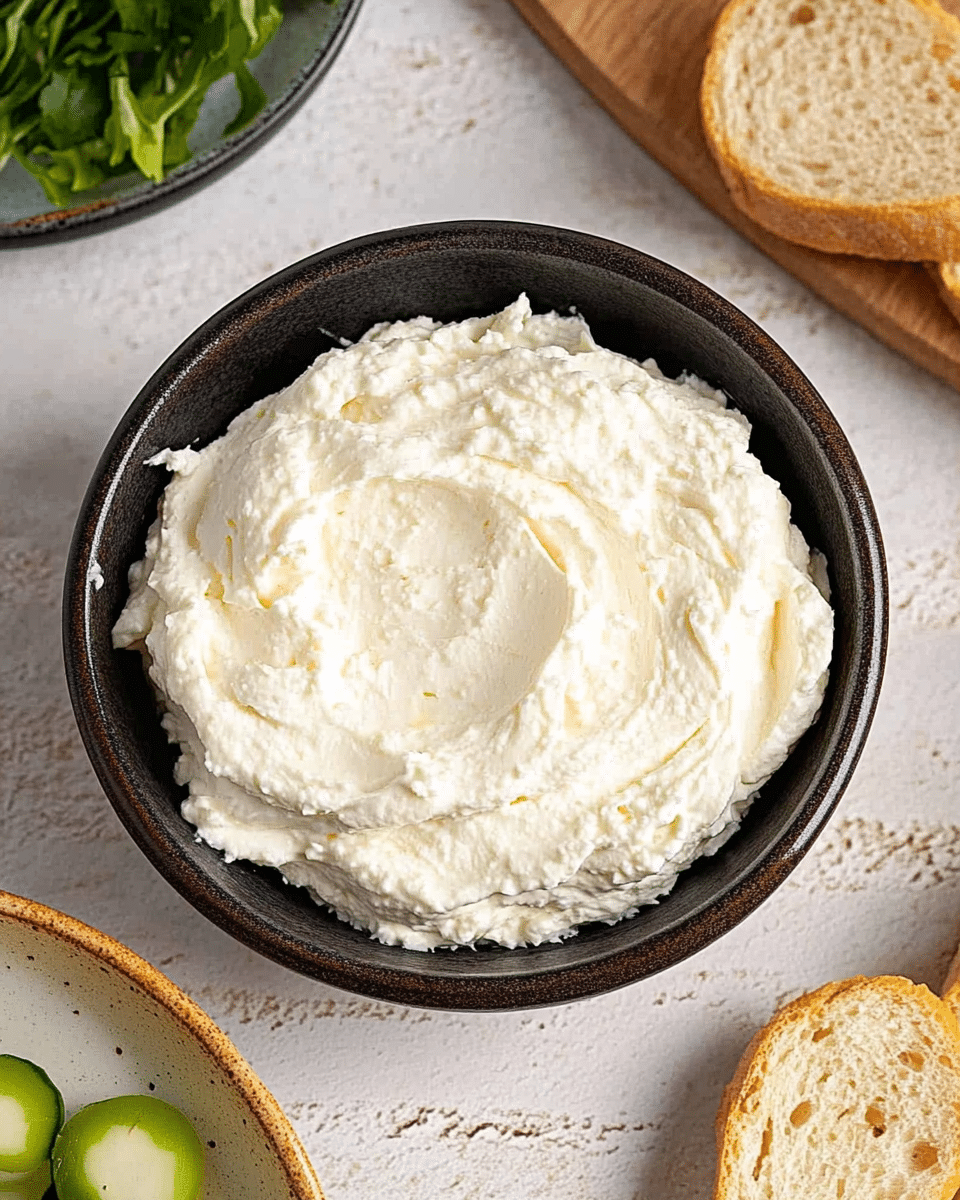
This simple homemade cream cheese recipe transforms just a few basic ingredients into a creamy, tangy spread that’s fresher and more flavorful than store-bought versions. With minimal effort, you’ll create a versatile dairy product that can be used in everything from breakfast to desserts.
Why You’ll Love This Recipe
This homemade cream cheese recipe offers numerous advantages over commercial versions. First, you’ll know exactly what’s in it—no additives, preservatives, or stabilizers. The fresh, clean flavor is noticeably superior, with a perfect balance of creaminess and tanginess that store-bought varieties can’t match. Making your own is also surprisingly economical, especially if you consume cream cheese regularly. Plus, there’s something deeply satisfying about transforming basic ingredients into something special through a bit of culinary chemistry. The process is simple enough for beginners but still feels like a rewarding kitchen accomplishment.
Ingredients
(Tip: You’ll find the full list of ingredients and measurements in the recipe card below.)
- Whole milk forms the foundation of this homemade cream cheese, providing the rich, fatty base necessary for a creamy final product. The higher fat content in whole milk delivers the luxurious texture we associate with quality cream cheese. For best results, use the freshest milk possible, preferably not ultra-pasteurized, as it curdles more effectively.
- Vinegar or lemon juice acts as the acidifying agent that causes the milk proteins to coagulate and separate from the whey. This ingredient is what transforms liquid milk into solid curds. White vinegar works reliably, but lemon juice adds a subtle citrus note that many prefer. You can experiment with both to determine your preference.
- Salt enhances flavor and acts as a natural preservative for your cream cheese. It balances the tanginess and brings out the dairy’s natural sweetness. Sea salt or kosher salt works particularly well, but regular table salt is perfectly acceptable too.
Directions
- Heat milk in a saucepan until it gently boils.
- Reduce heat, add vinegar or lemon juice slowly while stirring until curds form.
- Let sit for 5 minutes.
- Strain curds through cheesecloth and squeeze out excess whey.
- Blend curds with salt until smooth.
- Refrigerate for 30 minutes to set before using.
Servings and Timing
This recipe yields approximately 1 cup (8 servings) of homemade cream cheese, with each serving being about 2 tablespoons. The entire process takes about 45 minutes, including:
- Prep time: 5 minutes
- Cook time: 10 minutes
- Setting time: 30 minutes
Each 2-tablespoon serving contains approximately 60 calories.
Variations
- Herb Cream Cheese: Mix in 1-2 tablespoons of finely chopped fresh herbs like chives, dill, basil, or parsley after blending.
- Garlic and Onion: Add 1 teaspoon of garlic powder and 1 tablespoon of finely minced green onions for a savory spread perfect for bagels.
- Sweet Cream Cheese: Incorporate 1 tablespoon of honey or maple syrup and ½ teaspoon of vanilla extract for a sweeter version ideal for fruit or desserts.
- Vegetable Cream Cheese: Fold in 2-3 tablespoons of finely diced vegetables like bell peppers, carrots, or cucumbers (be sure to remove excess moisture first).
- Spicy Cream Cheese: Add ½ teaspoon of red pepper flakes or a minced jalapeño for a kick of heat.
Storage/Reheating
- Homemade cream cheese will keep in an airtight container in the refrigerator for up to 1 week. For best results, store it in a glass container with a tight-fitting lid. The texture may become slightly firmer as it sits, which is normal.
- To extend shelf life, you can add an additional ¼ teaspoon of salt, which acts as a natural preservative. However, this will affect the flavor.
- Cream cheese should never be reheated directly. If you need softened cream cheese for a recipe, simply let it sit at room temperature for 30-45 minutes before using.
- Freezing is not recommended as it significantly alters the texture, making it grainy and less creamy when thawed.
FAQs
Why didn’t my milk separate properly into curds and whey?
This usually happens if your milk is ultra-pasteurized. Ultra-pasteurized milk has been heated to such high temperatures that the proteins have already been denatured, making them less likely to curdle properly. Try using regular pasteurized milk instead. Also, ensure your vinegar or lemon juice is fresh and adequately acidic.
My cream cheese turned out grainy. What went wrong?
Graininess typically occurs when the curds are overworked or processed at too high a speed. For the smoothest texture, process the curds gently in a food processor at a low speed, gradually increasing as needed. You can also try adding 1-2 tablespoons of heavy cream during blending to improve smoothness.
Can I use low-fat or skim milk instead of whole milk?
While you can technically use low-fat or skim milk, the resulting cream cheese will be significantly less creamy and may have a slightly grainy texture. The fat in whole milk is essential for achieving that classic cream cheese consistency. If dietary concerns are a factor, a better alternative would be to make a smaller batch with whole milk rather than a full batch with low-fat milk.
How does homemade cream cheese compare nutritionally to store-bought?
Homemade cream cheese typically contains fewer calories and less sodium than commercial varieties, since you control the amount of salt added. It also lacks the stabilizers, preservatives, and thickeners found in most store-bought versions. However, the fat content is similar, as both rely on milk fat for their creamy texture.
Can I use this homemade cream cheese for baking cheesecakes?
Yes, this homemade cream cheese works beautifully in cheesecakes and other baked goods. However, it does have a slightly higher moisture content than commercial cream cheese, so you might need to adjust other liquid ingredients in your recipe slightly. Some bakers prefer to strain the homemade cream cheese through cheesecloth for an additional few hours in the refrigerator before using it in baking.
What can I do with the leftover whey?
The whey is highly nutritious and can be used in numerous ways. Add it to smoothies for a protein boost, use it instead of water when making bread or pizza dough, substitute it for some of the liquid in soups and stews, or use it to cook grains like rice or quinoa for added nutrition.
My cream cheese didn’t set firmly enough. How can I fix this?
If your cream cheese is too soft, it likely contains too much moisture. Return it to a fine-mesh strainer lined with cheesecloth and place in the refrigerator for several hours or overnight to allow more whey to drain. Gently pressing down with a weight can help extract additional liquid.
Can I double or triple this recipe?
Absolutely! This recipe scales up beautifully. Just maintain the same proportions of ingredients and ensure you have a large enough pot for heating the milk and sufficient cheesecloth for straining the increased volume of curds.
Is there a way to make this cream cheese tangier?
For a tangier cream cheese, you can add an additional 1-2 teaspoons of lemon juice to the finished product during the blending stage. Alternatively, let the milk and acid mixture sit longer (10-15 minutes instead of 5) before straining, which allows more acid development.
Can I make this recipe dairy-free?
This specific recipe requires dairy milk to create the proper curds. For a dairy-free alternative, you would need a completely different approach using soaked and blended cashews or commercially available cultured non-dairy bases, which is essentially a different recipe altogether.
Conclusion
Making homemade cream cheese is a surprisingly simple process that delivers remarkable results. With just three basic ingredients and less than an hour of mostly hands-off time, you can create a fresh, preservative-free cream cheese that outshines anything from the grocery store. The versatility of this base recipe allows for countless customizations to suit your taste preferences or complement specific dishes. Whether spread on a warm bagel, incorporated into a decadent cheesecake, or used as the foundation for a savory dip, this homemade cream cheese demonstrates that some foods are truly worth the small effort to make from scratch. Beyond the superior taste and texture, there’s a genuine satisfaction in crafting this kitchen staple yourself—connecting you to traditional food preparation methods that have been used for generations.
Print
Homemade Cream Cheese
- Total Time: 45 minutes
- Yield: 8 servings (2 tbsp each)
- Diet: Vegetarian
Description
A simple homemade cream cheese recipe made with milk, vinegar or lemon juice, and salt. Perfect for spreads or as an ingredient in dishes.
Ingredients
- 4 cups whole milk
- 2 tablespoons vinegar or lemon juice
- ¼ teaspoon salt
Instructions
- Heat milk in a saucepan until it gently boils.
- Reduce heat, add vinegar or lemon juice slowly while stirring until curds form.
- Let sit for 5 minutes.
- Strain curds through cheesecloth and squeeze out excess whey.
- Blend curds with salt until smooth.
- Refrigerate for 30 minutes to set before using.
Notes
- You can adjust the salt to taste.
- Lemon juice imparts a slight tangy flavor, which enhances the cream cheese’s taste.
- Store in an airtight container in the refrigerator for up to one week.
- Prep Time: 5 minutes
- Cook Time: 10 minutes
- Category: Condiments, Spreads
- Method: Heating, Blending
- Cuisine: Universal
Nutrition
- Serving Size: 2 tbsp
- Calories: 60







